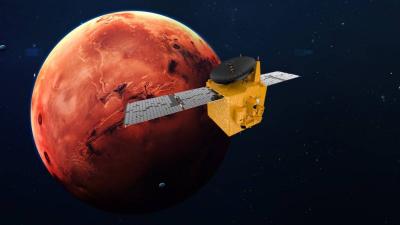The UAE Mars Exploration project, "Hope Probe," has released the second batch of scientific data gathered by its scientific instruments as part of its mission to explore the climate and atmosphere of the Red Planet. This second release of scientific data has been published through the information center on the UAE Mars Exploration project’s website https://sdc.emiratesmarsmission.ae/. It reaffirms the commitment of the UAE to share this valuable scientific data with the global scientific community, aiding scientists, researchers, and space enthusiasts in understanding the phenomena and interactions occurring in the Martian atmosphere.
Engineer Imran Sharaf, Project Manager for the UAE Mars Exploration "Hope Probe," stated that the release of the second batch of valuable scientific data collected by the probe as part of its mission about the Red Planet, according to the approved timeline, confirms the UAE’s ongoing commitment to contributing to the advancement of science for humanity by making this scientific data accessible to the global scientific community and specialists interested in space sciences.
### Unprecedented Data
Engineer Hessa Al-Matrooshi, Deputy Manager of the UAE Mars Exploration "Hope Probe" for Scientific Affairs, mentioned, "The second batch of scientific data collected by the probe covers the period from May 23 to August 31, 2021. Like the first batch, it includes important and unprecedented information that will help the global scientific community to develop more accurate scientific models of Mars' atmosphere, contributing to a deeper understanding of its changes. We will continue to release and make new data batches available every three months for the benefit of specialists and those interested in space sciences worldwide."
The second batch published contains 76 gigabytes of information, images, and scientific data collected by the scientific instruments aboard the "Hope Probe" during the initial months of its mission around the Red Planet, specifically between May 23 and August 31, 2021.
The UAE Mars Exploration project "Hope Probe" had previously declared its commitment to publish the collected scientific data and provide it free of charge to the global scientific community, in quarterly batches, every three months. Last October, it released the first batch of scientific data collected by the probe's three scientific instruments during the period from February 9 to May 22, 2021.
### Unique Images
The first batch of scientific data included unique images of Mars capturing unprecedented observations regarding the behavior of gases in the atmosphere and the interactions occurring among them. These observations revealed significant differences in the abundance of atomic oxygen and carbon monoxide in Mars' upper atmosphere on the daytime side of the planet, as well as unexpected structures in terms of size and complexity, which will impact the currently known scientific models of the Martian atmosphere and enhance scientists' understanding of its changes and interactions.
The first batch of scientific data published by the UAE Mars Exploration project "Hope Probe" garnered clear interest and engagement from scientists, researchers, and space enthusiasts worldwide. In the first ten days of making this data available to the global scientific community and the public via the data center on the project’s website, approximately 2 terabytes were downloaded, including 1.5 terabytes of data from the probe's exploration camera.
The "Hope Probe" carries three innovative scientific instruments: the EXI digital exploration camera, which captures high-resolution color images of Mars and is also used to measure ice and ozone in the lower atmosphere; the EMIRS infrared spectrometer, which measures temperatures, the distribution of dust, water vapor, and ice clouds in the lower atmosphere; and the EMUS ultraviolet spectrometer, which measures oxygen and carbon monoxide in Mars' thermosphere, as well as hydrogen and oxygen in Mars' outer atmosphere.
The scientific mission of the UAE Mars Exploration project "Hope Probe" focuses on collecting data and observing phenomena that will help study the relationship between the upper and lower layers of Mars' atmosphere, allowing the scientific community to create a comprehensive picture of Mars' climate and atmosphere at different times of the day and across Martian seasons.
Currently, the "Hope Probe" continues to orbit in its planned scientific orbit around Mars, which ranges between 20,000 and 43,000 kilometers with an inclination of 25 degrees toward Mars, allowing it to complete one orbit around the planet every 55 hours and capture comprehensive observations of the planet every nine days.
The UAE Mars Exploration project "Hope Probe" culminates knowledge transfer operations and development efforts that began in 2006, where UAE engineers worked with scientific partners from around the world to develop satellite designs and engineering capabilities. The "Hope Probe" weighs around 1,350 kilograms, equivalent to a small SUV, and was designed and developed by engineers at the Mohammed bin Rashid Space Centre in collaboration with academic partners, including the Atmospheric and Space Physics Laboratory at the University of Colorado in Boulder, Arizona State University, and the University of California in Berkeley.




